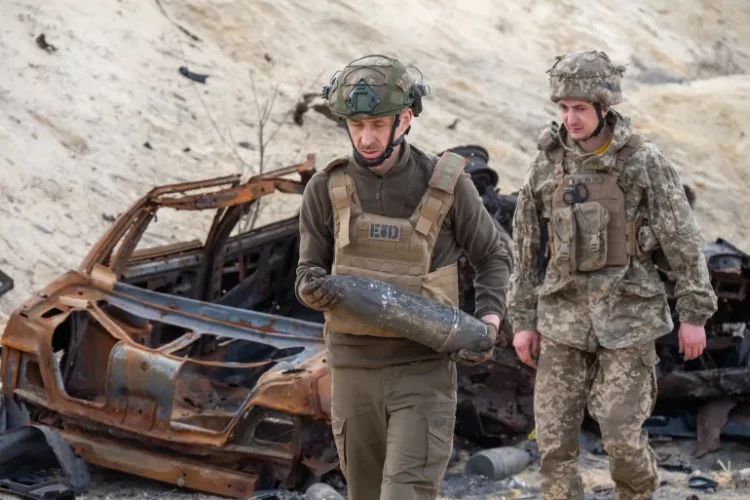The Russia-Ukraine war, which began in February 2022, has evolved into one of the most significant geopolitical crises of the 21st century. The conflict has reshaped global politics, economics, and security, reverberating through markets and causing profound disruptions in the global supply chain. The war has not only led to human suffering and humanitarian crises but has also drastically changed the global investment landscape, particularly in terms of market volatility, energy prices, and inflation.
As the conflict continues to evolve, investors are faced with an important question: How should geopolitical risks, particularly the Russia-Ukraine conflict, influence investment portfolio allocations? Will traditional asset classes like equities, bonds, and commodities still hold their ground, or will new approaches need to be adopted to safeguard wealth amidst escalating uncertainty?
This article explores the ongoing geopolitical risks introduced by the Russia-Ukraine conflict, assesses their impact on global markets, and discusses how investors should adjust their portfolios to navigate an increasingly volatile and unpredictable environment.
1. Geopolitical Risk: The Russia-Ukraine Conflict’s Impact on Global Markets
The Russia-Ukraine war has set off a chain reaction in global markets, with far-reaching consequences. While the immediate impacts have been clear—rising energy prices, supply chain disruptions, and inflationary pressures—the longer-term ramifications are still unfolding.
1.1 Energy Price Surge and Inflationary Pressures
One of the most notable effects of the Russia-Ukraine conflict is its impact on energy prices. Russia, as one of the world’s largest oil and gas producers, plays a central role in global energy markets. The imposition of sanctions on Russia, combined with disruptions in supply chains, led to significant spikes in oil, gas, and commodity prices.
- Oil and Gas Prices: Energy prices have surged globally, leading to inflationary pressures. Western countries, particularly in Europe, which were heavily dependent on Russian natural gas, are now scrambling to diversify their energy sources. The volatility in energy markets has had ripple effects on transportation costs, agricultural prices, and industrial production.
- Food and Fertilizer Shortages: Russia and Ukraine are major global exporters of wheat, corn, and fertilizers. The war has disrupted the supply of these essential goods, contributing to rising food prices and shortages in many parts of the world.
- Inflation: The surge in energy and commodity prices has contributed to global inflation, with the U.S. and Europe seeing the highest inflation rates in decades. This has forced central banks to hike interest rates, impacting bond markets and equity valuations.
1.2 Supply Chain Disruptions and Market Volatility
The conflict has disrupted global supply chains, particularly in Europe. Ukraine is a key producer of critical raw materials, including neon gas, which is essential for semiconductor manufacturing, as well as steel, wheat, and sunflower oil. Russia, on the other hand, is a major supplier of energy resources and metals like aluminum, nickel, and palladium, which are crucial for industries ranging from automotive to electronics.
- Shortages of Key Components: As industries in the West and Asia grapple with the shortage of key materials, manufacturers are facing delays and higher input costs, reducing profitability and increasing market uncertainty.
- Commodity Market Volatility: Geopolitical uncertainty has exacerbated volatility in commodity markets, with investors now pricing in the risk of further supply disruptions, particularly for oil, natural gas, and agricultural products.
- Market Risk and Uncertainty: Global stock markets have reacted to geopolitical instability with heightened volatility. Investors have seen significant swings in asset prices as they attempt to gauge the economic implications of the war. The conflict also raised concerns about the possibility of a broader military escalation, such as the direct involvement of NATO or other global powers.
1.3 Shifting Alliances and Global Trade Flows
The war has further reshaped global alliances and trade dynamics. Russia, facing international sanctions, has deepened its economic ties with China and other non-Western countries. Similarly, Europe and the U.S. are seeking to strengthen their economic and political ties with countries in Asia, the Middle East, and Africa.
- Sanctions and Economic Decoupling: Western sanctions on Russia have forced countries to reconsider their trade partnerships. The international push for “decoupling” between Western economies and authoritarian regimes has gained momentum. This has led to supply chain reconfigurations and the potential for economic fragmentation, especially in the technology and energy sectors.
- Shift in Global Trade Routes: As sanctions and trade disruptions affect the traditional East-West trade routes, alternative pathways and markets are emerging, especially in regions like Asia, Africa, and Latin America. These regions are becoming more attractive for investment, as they are less affected by the direct consequences of the war and may see more trade opportunities.
2. Geopolitical Risks and Investment Portfolio Adjustments
Given the significant uncertainty caused by the Russia-Ukraine conflict, investors must adjust their portfolios to mitigate risk while capitalizing on new opportunities. Here are several key strategies to consider:
2.1 Hedging Against Inflation and Currency Volatility
Inflation is one of the primary economic consequences of the Russia-Ukraine war. The sharp rise in energy and commodity prices is eroding purchasing power worldwide, and many central banks have responded by raising interest rates.
- Inflation-Protected Securities (TIPS): Investors looking to hedge against inflation may consider adding TIPS (Treasury Inflation-Protected Securities) to their portfolios. These government-issued bonds are designed to adjust with inflation, providing a safeguard against rising prices.
- Commodity Exposure: Direct exposure to commodities like gold, oil, and agricultural products may also offer a hedge against inflation. Commodities tend to perform well in inflationary environments, and energy and food prices are likely to remain volatile in the short to medium term.
- Foreign Currency Investments: As central banks raise interest rates to combat inflation, currency markets may experience significant fluctuations. Investors can potentially gain from currency diversification by holding assets in strong currencies like the U.S. dollar or Swiss franc, which traditionally perform well during periods of global uncertainty.

2.2 Sector and Geographic Diversification
The Russia-Ukraine conflict highlights the importance of diversification in managing geopolitical risks. Certain sectors and regions are more vulnerable to the impacts of the war, while others may present new opportunities for growth.
- Energy Sector: As the energy crisis continues, the energy sector (particularly oil and natural gas) remains highly volatile. However, this sector can also be profitable for investors who are willing to take on risk. Companies that focus on renewable energy, such as wind, solar, and green hydrogen, offer growth potential in the context of climate policies and energy transition.
- Defense and Cybersecurity: The war has spurred an increase in defense spending across Europe and NATO countries. Investors may consider allocating capital to defense contractors, cybersecurity firms, and companies providing military-grade technologies.
- Emerging Markets: The economic fallout from the war is particularly severe in Europe, but emerging markets, especially those in Asia and Africa, may be more insulated. Countries in these regions are less reliant on Russian energy and are therefore better positioned to weather the storm. Moreover, the U.S. dollar’s dominance in global trade means that markets outside of Russia and Europe might offer growth opportunities.
2.3 Risk Management and Portfolio Rebalancing
Risk management is essential in the face of geopolitical uncertainty. While it’s impossible to predict the precise direction of the war or its long-term consequences, investors can implement strategic measures to protect their portfolios:
- Bond Allocation: Bonds, especially short-duration bonds and high-quality corporate bonds, are generally less volatile than equities during geopolitical crises. In addition, high-yield bonds may offer attractive returns in an environment where central banks are raising rates. However, bond investors should remain cautious about rising interest rates.
- Equity Exposure: Equities in certain sectors (such as defense, energy, and infrastructure) are likely to outperform in the short term. However, equity investors should be selective and cautious about industries that are heavily exposed to supply chain disruptions or high commodity prices, such as automotive and consumer goods.
- Alternative Investments: As the traditional asset classes face increased volatility, investors may seek opportunities in alternative investments such as private equity, real estate, or infrastructure. These assets tend to be less correlated with public markets and may offer more stable returns during periods of geopolitical tension.
3. Conclusion: Navigating a Changing Geopolitical Landscape
The ongoing Russia-Ukraine conflict is a stark reminder of how geopolitical risks can dramatically affect global markets and investment portfolios. The war has disrupted energy markets, created inflationary pressures, and prompted shifts in global trade dynamics. Investors are faced with the challenge of managing these risks while also seizing opportunities that arise from this changing environment.
Strategically adjusting investment portfolios to include inflation hedges, diversify across sectors and geographies, and focus on sectors like defense, energy, and technology will be crucial in navigating the current geopolitical landscape. While the Russia-Ukraine conflict will undoubtedly continue to create volatility and uncertainty in the near term, it is also shaping the future of global markets. Investors who remain vigilant and proactive, balancing risk and opportunity, may emerge with new avenues for growth in an increasingly unpredictable world.


















































